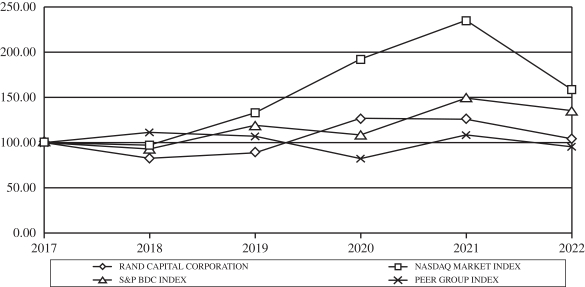RAND CAPITAL CORPORATION AND SUBSIDIARIES
NOTES TO THE CONSOLIDATED FINANCIAL STATEMENTS (Continued)
The Corporation holds debt securities in its investment portfolio that contain payment-in-kind (“PIK”) interest provisions. PIK interest, computed at the contractual rate specified in each debt agreement, is periodically added to the principal
balance of the debt and is recorded as interest income. Thus, the actual collection of this interest may be deferred until the time of debt principal repayment.
Revenue Recognition – Dividend Income – The Corporation may receive cash distributions from
portfolio companies that are limited liability companies or corporations, and these distributions are classified as dividend income on the consolidated statement of operations. Dividend income is recognized on an accrual basis when it can be
reasonably estimated.
The Corporation may hold preferred equity securities that contain cumulative dividend provisions. Cumulative
dividends are recorded as dividend income, if declared and deemed collectible, and any dividends in arrears are recognized into income and added to the balance of the preferred equity investment. The actual collection of these dividends in arrears
may be deferred until such time as the preferred equity is redeemed.
Revenue Recognition – Fee
Income – Consists of the revenue associated with the amortization of financing fees charged to the portfolio companies upon successful closing of a financing and income associated with portfolio company board attendance fees.
The income associated with the amortization of financing fees was $120,914, $87,018 and $29,188, for the years ended December 31, 2022, 2021 and 2020, respectively, and is estimated to be approximately $114,000 in 2023, $105,000 in 2024 and
$100,000 in 2025. The board fees earned were $25,000, $14,096 and $0 for the years ended December 31, 2022, 2021 and 2020, respectively. During the year ended December 31, 2022, the Corporation recorded $10,000 in non-recurring loan monitoring fees. During the year ended December 31, 2021, the Corporation recorded $55,500 in non-recurring fees related to prepayment fees,
application fees and loan monitoring fees. During the year ended December 31, 2020, the Corporation recorded non-recurring fees of approximately $96,000 that represented prepayment fees.
Realized Gain or Loss and Unrealized Appreciation or Depreciation of Investments – Amounts reported as realized
gains and losses are measured by the difference between the proceeds from the sale or exchange and the cost basis of the investment without regard to unrealized gains or losses recorded in prior periods. Proceeds held in escrow are reported in other
assets. The cost of securities that have, in management’s judgment, become worthless are written off and reported as realized losses when appropriate. Unrealized appreciation or depreciation reflects the difference between the valuation of the
investments and the cost basis of the investments.
Original Issue Discount – Investments may include
“original issue discount”, or OID, income. This occurs, for example, when the Corporation purchases a warrant and a note from a portfolio company simultaneously, which requires an allocation of a portion of the purchase price to the
warrant and reduces the purchase price allocated to the note by an equal amount in the form of a note discount or OID. The note is reported net of the OID and the OID is accreted into interest income over the life of the loan. The Corporation
recognized $25,008, $112,175 and $47,801 in OID income for the years ended December 31, 2022, 2021 and 2020, respectively. OID income is estimated to be approximately $15,000 for 2023.
Deferred Financing Fees – Origination and commitment costs related to the senior secured revolving credit facility
with M&T Bank, (See Note 5 “Senior Secured Revolving Credit Facility”), are amortized ratably over the term of the Credit Agreement. Amortization expense was approximately $12,500 for the year ended December 31, 2022. Amortization
expense is estimated to be $25,000 in 2023, $25,000 in 2024, and $25,000 in 2025
Deferred Debenture
Costs – SBA debenture origination and commitment costs, which are netted against the debenture, are amortized ratably over the term of the SBA debentures. In November 2021, Rand SBIC repaid its $11,000,000 in outstanding
debentures to the SBA and expensed all remaining SBA debenture origination and commitment costs. In addition, in November 2021, Rand SBIC received approval from the SBA to surrender its SBA license. There was no amortization expense for the year
ended December 31, 2022. Amortization expense was approximately $175,400 and $37,700 for the years ended December 31, 2021 and 2020, respectively.
81
